

15 Best teaching vocabulary strategies images. Vocabulary Acquisition Strategies: What Will Work in Your Classroom. One of the biggest struggles in every classroom is making sure students have the appropriate vocabulary skills to succeed with both general and content-specific tasks.

If a child knows and understands the concepts of mass, gravity, and acceleration, but doesn't understand what the words "compare" or "contrast" mean, they won't be able to tackle questions that gauge their understanding of these topics. Vocabulary acquisition strategies are useful across content areas, and help students build deep, meaningful learning structures whereby they can learn, utilize, and even play with new terms.
21 Ideas for Teaching Vocabulary in the Classroom. 21 Ideas for Teaching Vocabulary in the Classroom I’m sharing 21 ideas for teaching vocabulary.
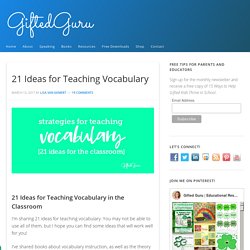
You may not be able to use all of them, but I hope you can find some ideas that will work well for you! I’ve shared books about vocabulary instruction, as well as the theory and techniques. This post is a lot more practical. We’re all about ideas today! IDEA #1: Semantic Maps In this activity, the teacher chooses a word and displays it for the class on a whiteboard, etc.. A list is created of all of the words that come to mind, and then those words are categorized. As students read through the text, they can add related words to the map. IDEA #2: Eye Spy. 21 Ideas for Teaching Vocabulary in the Classroom. Vocabulary: Instruction. Vocabulary Strategies. Five Research-Based Ways to Teach Vocabulary. Did you know that typically, only 5% to 10% of instructional time is devoted to vocabulary instruction, yet students, especially struggling students and English learners (ELs), need between 12 and 14 exposures to words and their meanings to fully learn them (Durkin, 1978/79; Roser & Juel, 1982; Scott, Jamieson, Noel, & Asslin, 2003)?
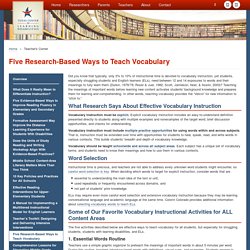
Teaching the meanings of important words before learning new content activates students' background knowledge and prepares them for learning and comprehending. In other words, teaching vocabulary provides the “Velcro” for new information to “stick to.” What Research Says About Effective Vocabulary Instruction Vocabulary instruction must be explicit. Explicit vocabulary instruction includes an easy-to-understand definition presented directly to students along with multiple examples and nonexamples of the target word, brief discussion opportunities, and checks for understanding. Vocabulary should be taught schoolwide and across all subject areas. Top Five Vocabulary Strategies for English Language Learners.
50,000 words by high school graduation.

That’s the challenge English Language Learners (ELLs) face if they want to catch up to their native English-speaking classmates. That’s almost 4,000 new words a year if a student begins school as a kindergartner! But what about the English Language Learners who don’t enroll until middle school or high school? For these students, the vocabulary challenge is even more demanding. To meet it, teachers must learn and use the most effective strategies. 10 effective vocabulary teaching strategies - Just Add Students. Teaching vocabulary can be a real challenge.
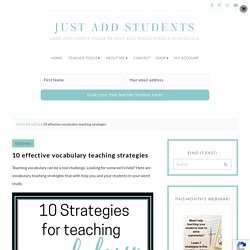
Looking for some extra help? Here are vocabulary teaching strategies that with help you and your students in your word study. I want you to know that this post contains affiliate links. As an Amazon Associate, I earn a small fee from any qualifying purchases you make. You can read more here. 6 Tips for Dealing With Difficult Vocabulary - Mr. Elementary.
When teaching reading, especially to ELL students, I always found myself struggling to find strategies to help them understand the meaning of new or difficult vocabulary.
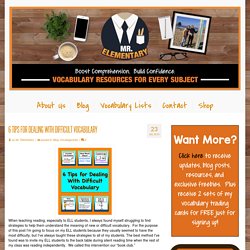
For the purpose of this post I’m going to focus on my ELL students because they usually seemed to have the most difficulty, but I’ve always taught these strategies to all of my students. The best method I’ve found was to invite my ELL students to the back table during silent reading time when the rest of my class was reading independently. We called this intervention our “book club.” I would always have a text picked out ahead of time, preferably focused on the content we were studying in science or social studies. I would have the group start by reading the text silently in their heads while I read my own copy. Next, we would go through the following steps for each word. For some colorful, printable, illustrated posters and flashcards with the strategies on them click here! 1. 2. 3. 4. 5. 6. 1. 2. 3. 4. 5. Strategies 1-3 - Vocabulary. 1) Concept of definition map What is it?
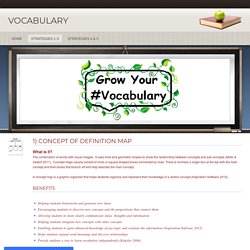
The combination of words with visual images. It uses lines and geometric shapes to show the relationship between concepts and sub concepts (Miller & Veatch 2011). Concept maps u su a lly consist of circle or square shaped boxes connected by lines. There is normally a larger box at the top with the main concept and then boxes that branch off and help describe the main concept. Benefits. 8 Strategies for Teaching ELL Students Vocabulary Words.
Strategy 1: Label Objects As a classroom teacher, building leader or district administrator, you should first ensure that the spaces ELL students inhabit most frequently have many object labels.

Whether these are classrooms or cafeterias, having signs that label each physical item in a room forces concrete connections through repeated exposure to the most basic of school concepts that native speakers often take for granted. You can use a template such as this one to create the labels. Teaching Vocabulary. Vocabulary is the knowledge of words and word meanings.
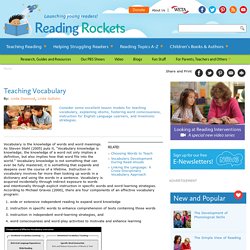
As Steven Stahl (2005) puts it, "Vocabulary knowledge is knowledge; the knowledge of a word not only implies a definition, but also implies how that word fits into the world. " Vocabulary knowledge is not something that can ever be fully mastered; it is something that expands and deepens over the course of a lifetime. Instruction in vocabulary involves far more than looking up words in a dictionary and using the words in a sentence.
Vocabulary Strategies. Teaching Strategies: 5 Ideas for Instructing Vocabulary. Undoubtedly, you remember the teaching strategies your instructors used for vocabulary: You would copy down definitions into our notebooks, and then for homework, rewrite each word for what seemed like a million times.
